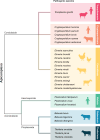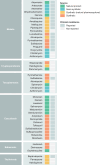A review of natural products as a source of next-generation drugs against apicomplexan parasites
- PMID: 40481189
- PMCID: PMC12144137
- DOI: 10.1038/s44259-025-00119-x
A review of natural products as a source of next-generation drugs against apicomplexan parasites
Abstract
Despite the substantial global health and economic burden of apicomplexan parasites in humans and livestock, treatment options remain limited. Natural products have long played an important role in combating these diseases, offering diverse chemical structures and bioactive compounds. This review summarises past and present natural-product-based therapies for six economically significant apicomplexans and explores the potential of revisiting natural products as a source of next-generation treatments.
© 2025. The Author(s).
Conflict of interest statement
Competing interests: Authors E.Y.M., B.E.S., M.R.G. and D.W.W. declare no financial or non-financial competing interests. Author S.W.P. holds shares in Advanced Veterinary Therapeutics, Luoda Pharma and Neoculi, and has previously acted as a paid consultant for Zoetis, Boehringer Ingleheim, Elanco, Virbac and Ceva but declares no financial or non-financial competing interests.
Figures


Similar articles
-
A screen of drug-like molecules identifies chemically diverse electron transport chain inhibitors in apicomplexan parasites.PLoS Pathog. 2023 Jul 20;19(7):e1011517. doi: 10.1371/journal.ppat.1011517. eCollection 2023 Jul. PLoS Pathog. 2023. PMID: 37471441 Free PMC article.
-
Revisiting Inflammatory Bowel Disease: Pathology, Treatments, Challenges and Emerging Therapeutics Including Drug Leads from Natural Products.J Clin Med. 2020 Apr 28;9(5):1273. doi: 10.3390/jcm9051273. J Clin Med. 2020. PMID: 32354192 Free PMC article. Review.
-
A conserved coccidian gene is involved in Toxoplasma sensitivity to the anti-apicomplexan compound, tartrolon E.Int J Parasitol Drugs Drug Resist. 2020 Dec;14:1-7. doi: 10.1016/j.ijpddr.2020.07.003. Epub 2020 Jul 25. Int J Parasitol Drugs Drug Resist. 2020. PMID: 32738587 Free PMC article.
-
Plasmodium falciparum Apicomplexan-Specific Glucosamine-6-Phosphate N-Acetyltransferase Is Key for Amino Sugar Metabolism and Asexual Blood Stage Development.mBio. 2020 Oct 20;11(5):e02045-20. doi: 10.1128/mBio.02045-20. mBio. 2020. PMID: 33082260 Free PMC article.
-
Ultrastructure expansion microscopy: Enlarging our perspective on apicomplexan cell division.J Microsc. 2025 Jan 24. doi: 10.1111/jmi.13387. Online ahead of print. J Microsc. 2025. PMID: 39853753 Review.
References
Publication types
Grants and funding
- IC220100050/Australian Research Council Industrial Transformation Training Centre
- IC220100050/Australian Research Council Industrial Transformation Training Centre
- IC220100050/Australian Research Council Industrial Transformation Training Centre
- IC220100050/Australian Research Council Industrial Transformation Training Centre
- 1135421/National Health and Medical Research Council of Australia
LinkOut - more resources
Full Text Sources
Miscellaneous

